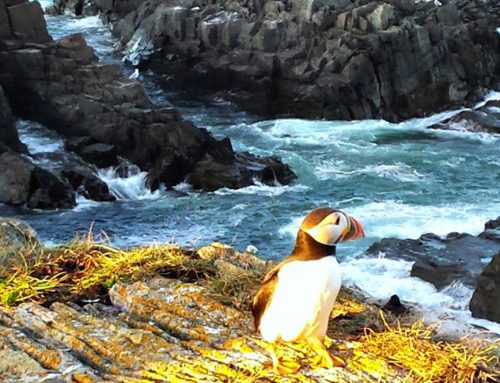By Jared Clarke
Feature article in the American Birding Association’s “Birder’s Guide to Travel” magazine
March 2016


Newfoundland (along with Labrador) is the easternmost province in Canada. Affectionately known as “The Rock”, it is a rugged island in the North Atlantic and, at 42,030 square miles (108,860 km2), is one of the largest islands in the world. Landscape and habitat vary greatly. From the limestone barrens of the Great Northern Peninsula to the thick boreal forests of the island’s interior, and the tundra and sheer cliffs that face the raging Atlantic, Newfoundland is an amazing place to experience. It’s no wonder that the National Geographic Society rated it atop the best coastal destinations in the world multiple times!
Newfoundland has a long and storied cultural history. Its people have been shaped by a harsh land and a ruthless sea. The island was inhabited by indigenous peoples dating back more than five thousand years: the Dorset Eskimo, the Maritime Archaic Indians, and the Beothuck. Vikings visited the island a millennium ago, forging their way into a new and exciting land. John Cabot arrived in 1497, and fishermen from many countries worked its waters and eked out a living
for hundreds of years, establishing some of the earliest settlements in North America. Despite the hardships, many loved it too much to leave.
And the birds love it there, too. Newfoundland boasts some of the largest seabird colonies in the
world, with astonishing numbers of Atlantic Puffin, Common Murre, Northern Gannet, and Black-legged Kittiwake lining rocky cliffs and islands. Forests are alive with northern songbirds including
Boreal Chickadee, Gray-cheeked Thrush, and Pine Grosbeak. Even the barrens, which often appear empty at first glance, are bountiful with species like Willow Ptarmigan, Horned Lark, and
Rough-legged Hawk. Winter brings a whole new suite of birds to the island, such as Dovekie, finches, Snowy Owl, flocks of Common Eider, and other sea ducks. And Newfoundland’s location, facing east across the open ocean, often brings rare visitors from across the Atlantic. These are the many reasons why birders come to visit Newfoundland, although sometimes it is the scenery and spectacle that amazes them most.
–
Visitors to eastern Newfoundland will revel in the opportunity to visit two spectacular seabird colonies. Witless Bay Ecological Reserve is home to millions of birds, including North America’s largest colony of Atlantic Puffns with more than 250,000 breeding pairs. Several hundred thousand Common Murres also nest here and can virtually cloud the sky at times. Not to be overlooked, Razorbills, Black-legged Kittiwakes, and the occasional Northern Fulmar dot the cliffs and water. Commercial boat tours offer birders the opportunity to enjoy these birds up close, often with a good chance of spotting whales and maybe even an iceberg along the way.
–
Click here to read the full-length article and enjoy the many photos in the Birder’s Guide to Travel.




Leave A Comment